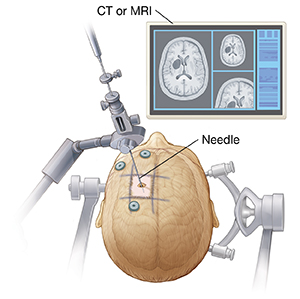Biopsy for a Brain Tumor
After finding out you have a brain tumor, your healthcare provider may decide that you need to have a biopsy. A biopsy is done by taking out a tiny piece of the tumor (tissue sample). The tumor sample taken during the biopsy will be tested in a pathology lab. Testing will find out the type of tumor and how fast it is growing (aggressiveness). The tumor can also be tested to see if it has certain genes or proteins that can make it easier to treat.
In some cases, a biopsy isn't needed because other tests show that the tumor is very likely not cancer. In other cases, a biopsy may not be possible because of where the tumor is.
Learn more about the 2 types of biopsies below. Both biopsies are performed by a neurosurgeon in an operating room.
Stereotactic biopsy
This type of biopsy is often done if a tumor is not near the surface of the skull. A special frame may be put around your head to hold it still. Or a frameless approach is used with small markers placed on the scalp around your head for reference during the procedure. A tiny hole is drilled into your skull and a long, thin hollow needle is put into your brain until it reaches the tumor. The healthcare provider uses a CT scan or MRI images and a computer system to guide the needle into the tumor. A tumor sample is then taken out through the needle.

Before the procedure
A few days before the procedure, you'll meet with your surgeon and sign consent forms. Be sure to ask any questions that you have. You'll be told how to get ready and if you can take your usual medicines before the biopsy. Blood thinners and aspirin are usually stopped days before the surgery. You may be told to not eat or drink for some time before the test. Before the biopsy, the hair over the area where the biopsy will be taken may be trimmed. Medicines may be used to help you sleep during the procedure (general anesthesia). Or you may be numbed to pain but awake during the biopsy. If a frame will be used, medicines are used to numb the part of your head where the surgeon will place the frame and drill the hole for the needle.
During the procedure
During the biopsy, a small hole will be drilled in the skull. The surgeon will pass a hollow needle through the hole, into the brain and the tumor. Cells taken from the tumor will then be sent to a pathology lab to be examined.
Risks and possible complications of stereotactic biopsy include:
-
Bleeding
-
Seizures
-
Infection
-
Need for another biopsy
Open biopsy
An open biopsy is done through an opening in the skull (craniotomy). In some cases, craniotomy is done after a stereotactic biopsy. You will likely be asleep or sedated for this procedure. A craniotomy allows an open biopsy to be done. Often the surgeon will take out as much of the tumor as possible at the same time as the biopsy.
Before the procedure
A few days before the procedure, you will have an exam, meet with your surgeon, and sign consent forms. Be sure to ask any questions that you have. You will learn if you can take your normal medicines before the biopsy. Blood thinners and aspirin are usually stopped days before the surgery. You may be told to not eat or drink for at least 8 hours before the test. Before the biopsy, the hair over the area where the biopsy will be taken may be trimmed. You may be asleep under general anesthesia or stay awake for part of the procedure. You will have anesthesia to numb the part of your head where the surgeon will be operating.
During the procedure
During the procedure, the scalp is cut and a piece of skull bone is taken out. This lets the healthcare provider access the brain. In most cases, the bone is put back in place after the biopsy or a metal plate is placed over the hole. Often an early diagnosis is made while you are still in the operating room. This is so the neurosurgeon knows how much surgery will need to be done.
Risks and possible complications of open biopsy include:
-
Bleeding
-
Seizures
-
Infection
-
Reaction to anesthesia
Planning the return home
As with any surgery, you may need some help when you return home. Plan ahead. Have people in mind to:
-
Drive you home from the hospital and to appointments
-
Keep track of the healthcare team's directions
-
Cook and take care of your house
-
Help take care of you